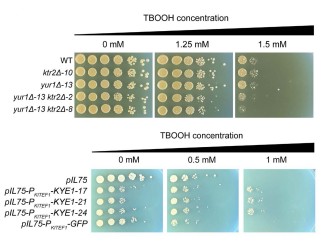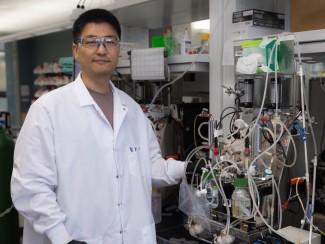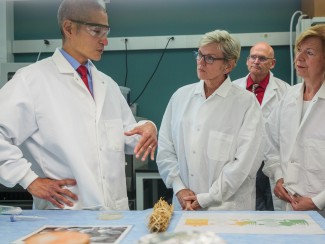
Alex Linz has thousands of multi-talented, microscopic labmates.
“Why do I love microbes? I think it’s just crazy that they’re all around us, and we can’t see them, and yet if you can dream it up, microbes probably do it,” says the UW–Madison postdoctoral researcher.
Linz is particularly interested in one microbe, Novosphingobium aromaticivorans, because of its unusually voracious appetite and broad palate. “[It] seems to eat just about anything you throw at it,” she says. “We don’t know how it’s doing it.”
By studying how N. aromaticivorans is able to consume different chemical compounds, Linz and her colleagues at the Great Lakes Bioenergy Research Center (GLBRC) hope to learn how to turn lignin, a tough plant material which is often wasted during biofuel production, into a useful product.
The possibility of turning lignin into the chemical ingredients for vanilla flavoring, bioplastics, or plant-derived fabrics—to name a few possibilities—is exciting because doing so could improve the economics and efficiency of the entire biofuel production process.

Experimenting with RNA
To use N. aromaticivorans to make bioproducts from lignin, scientists must first understand the metabolic pathways by which the microbe consumes different substances.
Linz is working on this question in GLBRC Director Tim Donohue’s lab at the Wisconsin Energy Institute. She feeds N. aromaticivorans either glucose (its preferred food) or a buffet of lignin-derived aromatic monomers—shorter molecules which are easier for microbes to eat than pure lignin. Then she watches to see what happens.
Specifically, Linz looks for RNA signals that indicate which genes the cell is actively using. Her goal is to find genes that become active when N. aromaticivorans grows on lignin monomers, but not when it grows on glucose. These genes may be involved in the metabolic pathways microbes use to consume the more difficult-to-digest lignin compounds. Scientists can then try to engineer those pathways to turn lignin into bioproducts.

N. aromaticivorans: not your average microbe
However, studying N. aromaticivorans is sometimes tricky. Most protocols for working with bacteria are written for E. coli, a more commonly studied bacterium, which means that Linz has to get creative at times when she applies techniques for RNA extraction to N. aromaticivorans.
For example, the very first step in RNA extraction is lysing, or breaking open, the cells. This normally results in a liquid that can then be pipetted into another tube for the next step. But lysing N. aromaticivorans resulted in a jelly-like substance instead of liquid, so Linz had to figure out another way to transfer it: she carefully poured it.
RNA also degrades easily, so extracting it is a challenge.
“We all secrete enzymes that can degrade RNA. If you’re trying to get it out of a cell and you breathe too close to the cell, it’s done,” she says.

Microbes past and future
Once Linz has identified genes involved in aromatic degradation, she and her labmates will explore how to optimize the pathway for creating different products. This may involve blocking side pathways that the organism uses to make less useful products, or tweaking genes through knockouts or insertions to increase the output of the desired product.
Linz sees her current work as an evolution of her time at UW–Madison. As an undergraduate, she worked in Donohue’s lab studying microbial hydrogen production. She earned her PhD working with civil and environmental engineering Professor Trina McMahon on the microbial ecology of lakes. Now, she situates her work within the larger context of what the Wisconsin Energy Institute and GLBRC hope to achieve for the future: clean energy systems and sustainable biofuels and bioproducts.
“I think energy is one of the big problems that’s facing our society today,” she says. “And I also love microbes. If we can put the microbes to work for us, that would be really exciting.”





